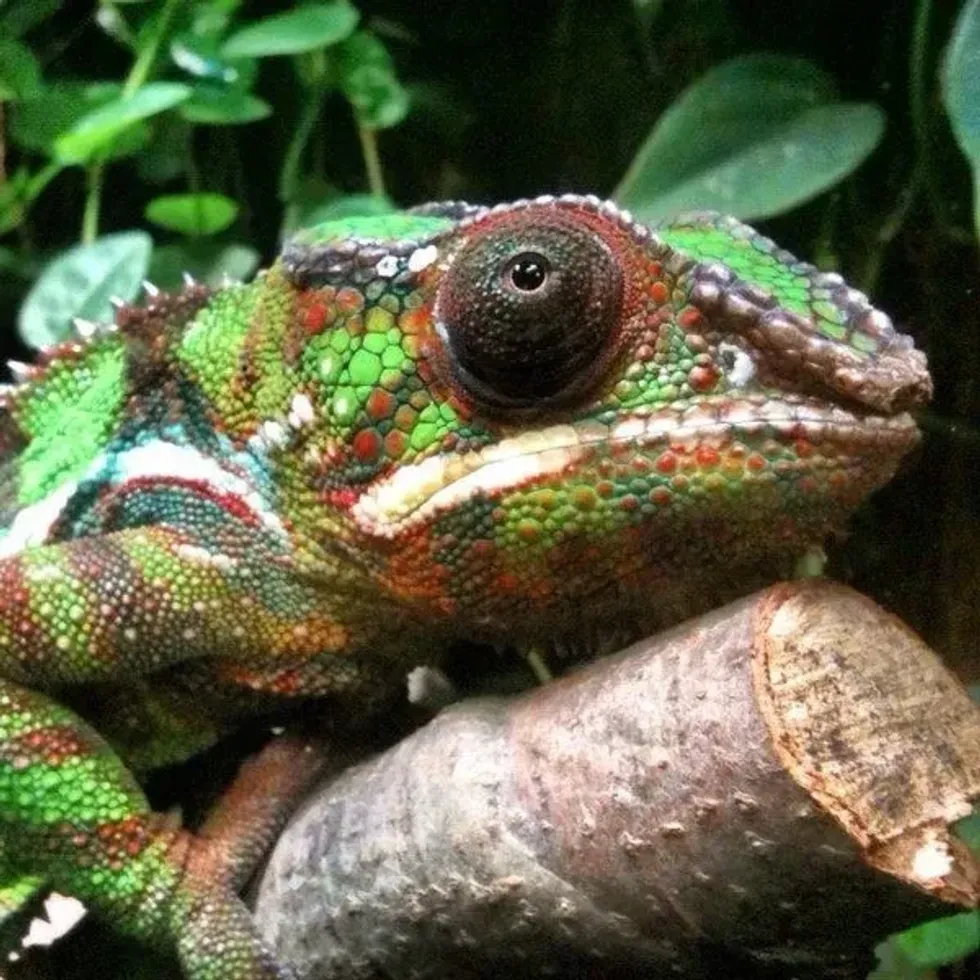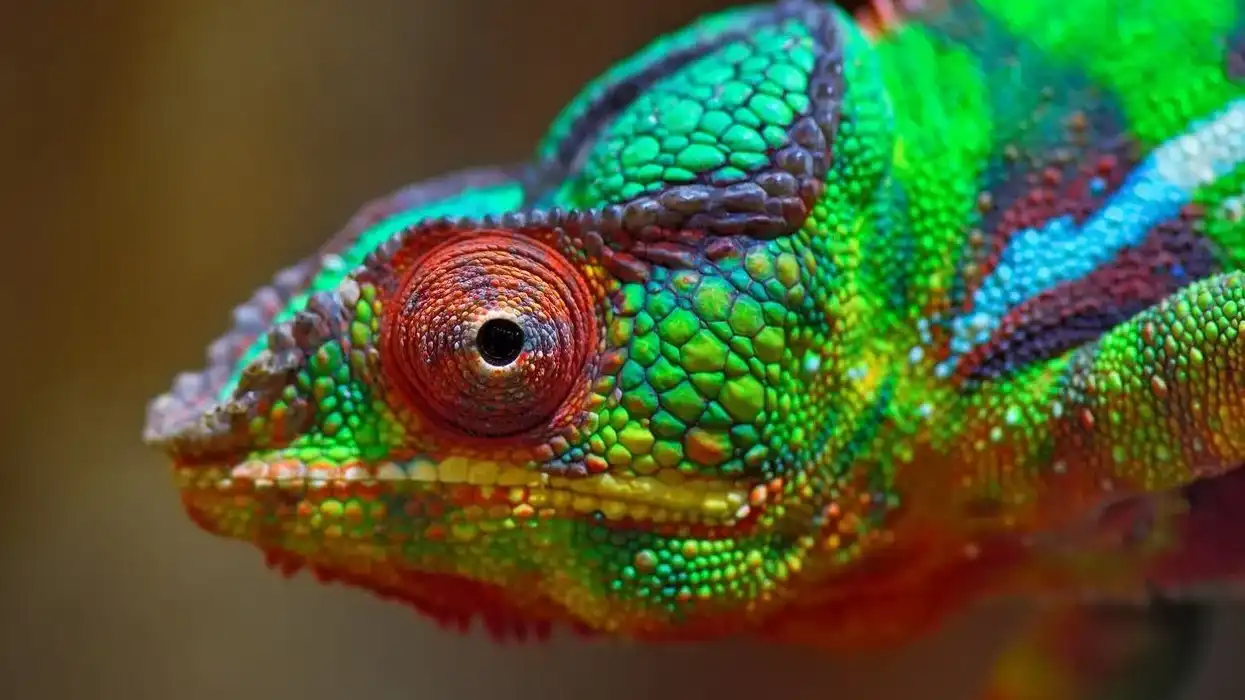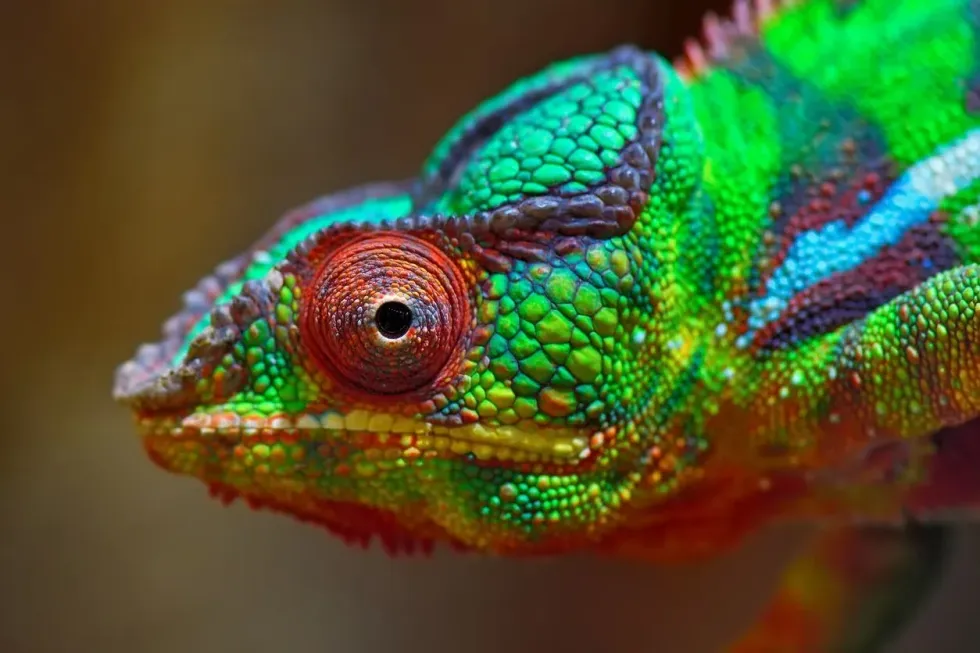Fun Panther Chameleon Facts For Kids

Content
- What type of animal is a panther chameleon?
- What class of animal does a panther chameleon belong to?
- How many panther chameleons are there in the world?
- Where does a panther chameleon live?
- What is a panther chameleon's habitat?
- Who do panther chameleons live with?
- How long does a panther chameleon live?
- How do they reproduce?
- What is their conservation status?
- What does the panther chameleon look like?
- How cute are they?
- How do they communicate?
- How big is a panther chameleon?
- How fast can a panther chameleon move?
- How much does a panther chameleon weigh?
- What are the male and female names of the species?
- What would you call a baby panther chameleon?
- What do they eat?
- Are they poisonous?
- Would they make a good pet?
- Did you know...
- Different types of chameleon
- Why do chameleons change color?
Chameleons changing color to blend in with their immediate surroundings is not new information. However, did you know that the panther chameleons are one of the most colorful chameleon species you could ever come across?
With a natural color range that would surely dim the shine of a rainbow, the panther chameleon is a species of chameleon native to the eastern and northern parts of Madagascar. It belongs to the genus Furcifer that includes several other chameleon species.
The sheer range of colors that the panther chameleons exhibit makes them a valuable and exotic asset in the international live pet trade.
The male panther chameleons, in particular, come in brilliant and vibrant color morphs. The female panther chameleons, on the other hand, are not as lavishly colored, are smaller, and do not have an elaborate helmet or ridges along the sides of the head.
What's more, these chameleons have unique tong toes that help them have a firm grip on the branches they climb on. In addition to four pairs of extremely useful tong-shaped feet, the panther chameleons have a long, prehensile tail that serves as an extra hand to hold on to tree branches.
The reptile simply curls its tail around the branch it is hanging on to and avoids toppling over!
It doesn't there.
The colorful panther chameleons have excellent vision provided by a pair of dome-shaped eyes that can swivel a full 180 degrees and allow the reptile to survey its surroundings without moving its head.
Add to that, the long, flexible, and sticky tongue of the panther chameleon are extremely efficient in catching insect prey and propelling it straight into the animal's mouth!
That's not all about these wonderfully cryptic and colorful chameleons of Madagascar. Read on to learn more about panther chameleon care!
If you like what you read, then why not engage and enlighten yourself with other interesting articles such as facts about the tuatara and leatherback sea turtle?
Panther Chameleon Interesting Facts
What type of animal is a panther chameleon?
The panther chameleon is a species of chameleon belonging to the family Chamaeleonidae.
What class of animal does a panther chameleon belong to?
Panther chameleons belong to the class Reptilia.
How many panther chameleons are there in the world?
An overall population estimate of the panther chameleon is not available. Since it is a species of Least Concern as per the International Union for Conservation of Nature (IUCN) Red List of Threatened Species, it can be considered that the species has an abundant number of individuals globally.
Where does a panther chameleon live?
Panther chameleons are endemic to Madagascar, an island country situated about 248 mi (400 km) off the coast of East Africa in the Indian Ocean. While these reptiles are distributed all throughout the island, they are particularly abundant in the northern, northeastern, northwestern, and central-eastern parts of Madagascar, especially near the coasts.
Overall, panther chameleons have a restricted habitat range.
Since they are arboreal and spend almost all their time on trees, panther chameleons require abundant vegetation in their habitat. Hence, for the survival of captive-bred panther chameleons, it is essential that the natural panther chameleon habitat conditions are replicated in captivity.
Keeping a panther chameleon as a pet calls for several requirements in terms of housing, temperature, and lighting. To begin with, a pet chameleon must never be kept in a glass terrarium or enclosure since they fail to provide adequate ventilation.
Ideally, a panther chameleon cage must be made of mesh that allows ample air circulation. Here again, it is best that the cage is not made of fiberglass mesh or fine metal, and it is recommended that the cage is made of PVC-coated hardware cloth.
In addition, the pet panther chameleon's cage should have enough room for the reptile to move about and climb.
A big and tall cage is always preferred since panther chameleons like to climb heights high off the ground. So, make sure to provide lots of strong non-toxic plants and branches with secure and comfortable perches at various levels.
Plants that are commonly used in chameleon housing include hibiscus, dracaena, pothos, and ficus. Artificial vines and plants are also great options.
The substrate of the panther chameleon's cage is as important as the size of the enclosure. Substrates such as wood chips are a big no since the chameleons might ingest these and choke themselves. Instead, a plain paper substrate is ideal.
Newspapers and paper towels can be used to line the cage. Placing live, potted plants inside the cage also works well. Mold or bacterial growth inside the cage must be prevented at all costs by always keeping the cage clean.
Once you have an ideal cage for your pet panther chameleon, the next job is to control the temperature, lighting, and humidity inside the enclosure. During the day, the temperature inside the cage should range between 75-90 F (24-32 C).
A basking spot that is a few degrees warmer than the rest of the cage would also be good. Nighttime temperatures inside the panther chameleon's cage must not drop below 15 F (-9 C). In addition, panther chameleons require an ultraviolet (UVB) light source for at least 10-12 hours per day.
Besides warmth, a pet panther chameleon would also require a highly humid environment. Thus, it is essential to always maintain the humidity level between 60-85 %.
What is a panther chameleon's habitat?
In the wild, panther chameleons inhabit coastal lowlands and dry deciduous forests near streams. The species thrives well in habitats that are warm, humid, and have very little temperature or weather fluctuations.
When in their wild, natural habitat, the panther chameleons are found living in shrubs, bushes, or short trees. Outside their wild habitat, the panther chameleon can be found in homes as a pet.
Who do panther chameleons live with?
Like most other chameleon species, the panther chameleon is a territorial and solitary animal. Male panther chameleons usually have larger home ranges than their female counterparts and are most often intolerant of other males invading their territorial trees or shrubs.
As a defensive display, the male chameleons often end up injuring the invaders. The hostile behavior tends to increase during the breeding season.
Hence, when panther chameleons are kept as pets, they should be housed individually to avoid bullying and fighting. In fact, two male panther chameleons kept together in captivity can change color and attack each other.
How long does a panther chameleon live?
Usually, the panther chameleon's lifespan in the wild rarely exceeds three years. In captivity, the reptiles have been known to live longer than five years. However, female panther chameleons typically have a shorter lifespan than males because of the stress they experience from reproduction.
How do they reproduce?
Mating in panther chameleons is preceded by the males engaging in an elaborate display of color patterns. The show of colors is accompanied by a series of jerking head movements while advancing towards the female.
During the breeding season, the females usually remain in their small territory and are visited by roaming males looking for a partner.
Since the species exhibits pair bonding, the males usually choose to remain with their mating partner for some time after breeding, taking care of the female and protecting it against other males. Although the breeding season may vary with the geographical location, the typical time is between January and May.
Successful mating is followed by a gestation period of three to six weeks. The gestation period is followed by the expecting females descending to the ground, digging a burrow, and depositing their eggs.
On average, a female panther chameleon lays about 10-40 eggs per clutch. However, the number of eggs a female panther chameleon lays depends on its nutrient uptake during the pregnancy.
The females use their front feet to dig the nesting burrow. After the eggs are laid, they are concealed with soil and often covered with plant materials so as to not give away the nest location.
With that, the duties of a panther chameleon mother end because panther chameleon babies are born independent. In fact, the species exhibit almost no parental investment.
Both males and females do nothing beyond creating and laying the eggs in a protected place.
The young panther chameleons are born with an egg tooth on their upper jawbone, which they use to crack open the eggshell and emerge. The newborns are on their own right from birth and reach breeding maturity when they are about six months old.
What is their conservation status?
As per the International Union for Conservation of Nature (IUCN) Red List of Threatened Species, the panther chameleon of Madagascar is a species of Least Concern.
Panther Chameleon Fun Facts
What does the panther chameleon look like?

Panther chameleons are known for their extraordinary range of colors. Adult males and females are easily distinguishable based on their physical characteristics.
The males have a wide range of color patterns, are larger in size, and have a swollen tail base. On the contrary, the females have less vibrant coloration, usually, tan, pale green, gray, or pink, are smaller in size, and have a thinner tail base.
In addition, male panther chameleons have an elaborate helmet or head casque that is protective in nature.
Both the males and females have a long tongue that can stretch to a length longer than the chameleon's body. The tongue is equipped with a sticky tip that effectively catches prey and pulls back into the mouth, much like that of a frog.
The eyes of the panther chameleons swivel like gun turrets, turning a full 180 degrees without the reptile having to move its head! Also unique are the panther chameleon's feet.
The specialized feet have a tong-like appearance. The five toes on each foot are fused into two groups of twos and threes.
In the front feet, the bundle of two toes is on the outside of the foot, and the bundle of three toes is on the inside. The arrangement is reversed on the rear feet, allowing the panther chameleons to tightly hold on to even the narrowest of branches.
Each toe is equipped with sharp claws that help the animal climb on surfaces such as tree trunks. The long and prehensile tail further helps in having a firm grip over branches.
How cute are they?
Panther chameleons do not quite fit the definition of cute. However, these reptiles are extremely beautiful and charming due to their vibrant colors.
How do they communicate?
Panther chameleons mostly communicate through changes in body coloration. For example, the male chameleons tend to assume more dazzling colors when engaging in physical bouts and amp up the color intensity when trying to attract a mating partner.
The ones losing the physical battles surrender by assuming dull or dark colors and retreating. Females also communicate their mating readiness through body coloration.
Before mating, the females don a receptive coloration to attract males, and once they are bearing eggs, the coloration of their stomachs changes to black or dark brown to signal that they are not open to mating anymore. Besides, panther chameleons have a pair of swiveling, dome-shaped eyes that are capable of independent movement and aid in visual hunting.
As one eye detects prey, the chameleon's head turns to focus both eyes on the target. Panther chameleons are diurnal (daytime) hunters.
How big is a panther chameleon?
Male panther chameleons can grow up to a length of 14-21 in (35-53 cm). Females are smaller, measuring 9-13 in (23-33 cm). They are almost the same size as veiled chameleons.
How fast can a panther chameleon move?
No information is available regarding the speed of panther chameleons. However, several sources suggest that these reptiles can move their long tongues extremely fast!
How much does a panther chameleon weigh?
On average, male panther chameleons weigh between 4.9-6.3 lb (140-180 g), and females weigh between 2.1-3.5 lb (60-100 g).
What are the male and female names of the species?
Male and female chameleons do not have sex-specific names.
What would you call a baby panther chameleon?
A baby chameleon is called a hatchling.
What do they eat?
The panther chameleon diet primarily includes insects. It may also feed on other terrestrial invertebrates. Captive-bred and pet panther chameleons may be fed crickets, roaches, locusts, silkworms, butter worms, grasshoppers, flies, waxworms, mealworms, and super worms. Panther chameleons rarely feed on plant matter.
Are they poisonous?
Panther chameleons are not known to be poisonous.
Would they make a good pet?
The panther chameleons of Madagascar are popular as exotic pets. Their docile demeanor and the impressive range of color patterns that these reptiles display make them a far better pet choice than other lizards.
However, they may not like to be held and cuddled since frequent handling stresses them and invites health problems. Depending on the breeder, color, and morph, a panther chameleon can cost anything between $150-600. Male panther chameleons may be more expensive than females due to the former's variety of colors.
Did you know...
The panther chameleon color varies with location, and the different color patterns are referred to as locales after the geographical location in which they are found. For instance, panther chameleons from Sambava, Antsiranana, and Ambilobe are orange, green, or red. Likewise, those from Ambanja, Ankify, and Nosy Be sport vibrant blue hues.
Different types of chameleon
Chameleons constitute a large family of Old World lizards with hundreds of species, each with its own range of colors and the ability to change color. Some of these species make excellent pets too.
Apart from the panther chameleon and veiled chameleon, some other chameleon types that make good pets include the Meller's chameleon, carpet chameleon, Fischer's chameleon, Jackson's chameleon, pygmy chameleon, and many more.
Why do chameleons change color?
Contrary to popular belief, chameleons do not change color to match their surroundings. Depending on the species, chameleons are born with a natural range of colors that are strongly affected by light, temperature, and the animal's mood.
Some chameleons are known to change coloration to adjust their body temperature. For example, a hot chameleon may turn pale to reflect the heat of the sun, and a cold chameleon will turn darker to absorb more heat and warm up.
Here at Kidadl, we have carefully created lots of interesting family-friendly animal facts for everyone to discover! For more relatable content, check out these thorny devil facts and Gila monster facts for kids.
You can even occupy yourself at home by coloring in one of our free printable reptile coloring pages.
We Want Your Photos!
More for You
Bachelor of Arts specializing in English

Arkoprabho SadhuBachelor of Arts specializing in English
Arkoprabho is an English graduate from Bidhannagar University with experience in academic writing on various subjects such as business management, law, and medicine. He is a published poet and enjoys films, music, and finance. As a member of the Content Updating team, he aims to become an expert in SEO content writing and editing. In his free time, he likes to write film scripts, research the stock market, and indulge in creative interests such as poetry writing, anime, and music.
Disclaimer
1) Kidadl is independent and to make our service free to you the reader we are supported by advertising. We hope you love our recommendations for products and services! What we suggest is selected independently by the Kidadl team. If you purchase using the Buy Now button we may earn a small commission. This does not influence our choices. Prices are correct and items are available at the time the article was published but we cannot guarantee that on the time of reading. Please note that Kidadl is a participant in the Amazon Services LLC Associates Program, an affiliate advertising program designed to provide a means for sites to earn advertising fees by advertising and linking to Amazon. We also link to other websites, but are not responsible for their content.
2) At Kidadl, we strive to recommend the very best activities and events. We will always aim to give you accurate information at the date of publication - however, information does change, so it’s important you do your own research, double-check and make the decision that is right for your family. We recognise that not all activities and ideas are appropriate for all children and families or in all circumstances. Our recommended activities are based on age but these are a guide. We recommend that these ideas are used as inspiration, that ideas are undertaken with appropriate adult supervision, and that each adult uses their own discretion and knowledge of their children to consider the safety and suitability. Kidadl cannot accept liability for the execution of these ideas, and parental supervision is advised at all times, as safety is paramount. Anyone using the information provided by Kidadl does so at their own risk and we can not accept liability if things go wrong.
3) Because we are an educational resource, we have quotes and facts about a range of historical and modern figures. We do not endorse the actions of or rhetoric of all the people included in these collections, but we think they are important for growing minds to learn about under the guidance of parents or guardians.







